A child at the age of 6 months should already be sitting on its own. But some children at this age cannot sit down in any way, do not show any special activity. This can be caused by various ailments., about which most of the parents do not even suspect.
Each child is different, so before sounding the alarm, it is better to consult with doctor, so for example, premature babies have 2 months in stock to catch up in development peers. If a full-term baby sits down at 6 months, then a premature baby can sit down at 8 and this will be the norm for him.
Record content:
-
1 Possible reasons
- 1.1 Weak muscle corset
- 1.2 ZPR (mental retardation)
- 1.3 Down Syndrome
- 1.4 CNS disorders
- 1.5 Rickets
- 1.6 Hip dysplasia
- 1.7 Muscle dystrophy
-
2 How to teach a child to sit
- 2.1 Physical training
- 2.2 Exercise to strengthen muscles
- 3 Massage and gymnastics to help the child crawl
- 4 What to do to get your child to stand up
- 5 Video about why the child is not sitting
Possible reasons
A child at 7-8 months does not sit often due to developmental delays and various factors can influence this situation.
If the child is not sitting, then the reasons for such a deviation may be as follows:
- difficult course of pregnancy: prolonged toxicosis, frequent threats of spontaneous miscarriage, Rh-conflict between mother and child, intrauterine infections, fetal hypoxia, anemia, prematurity;
- fast and rapid labor, using forceps, birth trauma to the child.
Also, the cause may be the child's illness.
Weak muscle corset
The muscle corset is the muscles of the back, chest and peritoneum. It is they who help to keep the spine correctly. If this muscle group is poorly developed, then this can provoke developmental delay. It is necessary to strengthen the muscle corset from the first days of a baby's life by performing special exercises.
ZPR (mental retardation)
It is difficult to make an accurate diagnosis, since this ailment has no obvious physical defects. Sometimes parents themselves attribute the diagnosis to their little child if they see that they are developing differently than their peers. If it is noticed that the child does not want to sit down or does not crawl, it is better to consult a pediatrician, only he will be able to find out the reason and make a diagnosis.
If it is noticed that the child does not want to sit down or does not crawl, it is better to consult a pediatrician, only he will be able to find out the reason and make a diagnosis.
Down Syndrome
This is a chromosomal pathology that provokes a violation of mental development, accompanying characteristic changes in appearance and slowing down of physical development.
CNS disorders
The central nervous system is one of the mechanisms of the human body, thanks to which a person interacts with the world around him.
In newborns, it is not yet fully formed and this requires time and effort. Often infants are impaired, and the nervous system does not develop correctly, which ultimately provokes complications. One of the complications is considered a violation in the development of a child, when in his 6-7 months he cannot sit, crawl or stand.
Rickets
This is a disease of young children, which is associated with metabolic disorders in the body and a lack of vitamin D. The disease primarily affects the bone tissue and the nervous system. If vitamin D in the body is in small quantities, then calcium and phosphorus from the digestive system are poorly absorbed. As a result, bones become fragile and developmental delay is observed.
Hip dysplasia
This is a congenital disorder associated with a disruption in the formation of joints, which can cause dislocation or subluxation of the femoral head. In newborns, the hip joint is not fully formed and this is the norm.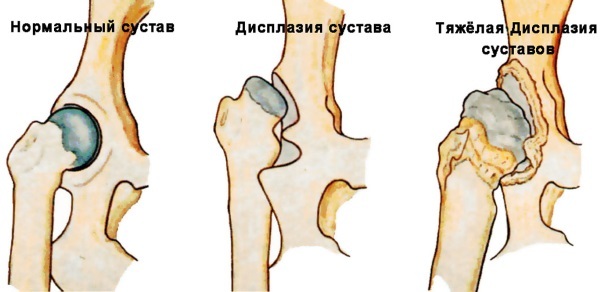
The immature joint is in a borderline state, but no disturbances have yet been observed. Untimely assistance of a specialist can lead to someone that the child will not be able to sit up, crawl and stand on time.
Muscle dystrophy
This is an incurable disease that requires constant supportive therapy that will simply help improve the condition. Treatment consists of physiotherapy. This ailment provokes a delay in the development of the baby.
Crawling is the most difficult skill for a child under one year old. The child prepares for it from the first days of his life. To start crawling, a child must have a strong back, good abs. He should turn easily and get on all fours. While crawling, the child needs to simultaneously move his arms and legs, follow his goal with his eyes and avoid all obstacles.
If the child, according to experts, is ready, then it is not worth worrying that at 6 months he does not crawl, but if at 8 months he did not crawl, then it is worth looking for the reason.
And there may be several reasons:
- Fetal hypoxia. This term refers to oxygen starvation of the fetus in the womb. More often this is observed in women who lead an unhealthy lifestyle or had bad habits. Previous abortions and disturbances of blood flow in the uterus also have a negative effect.
- Microtrauma of the cervical spine. More often, injuries occur if the tactics of labor management were chosen incorrectly or due to an obstetrician's mistake. This can lead to dysfunction of the nervous system.
-
Pregnancy infections. Any ailment suffered by a woman while carrying a fetus can provoke unpleasant consequences in an infant. That is why it is recommended that a pregnant woman protect herself from colds, infections and viruses. Such diseases are especially dangerous for a pregnant woman: measles, rubella, chickenpox, and especially in the first 3 months of pregnancy.

These problems can easily be dealt with in a few sessions by orthopedic surgeons. Wellness gymnastics will also help.
A child at 7-8 months does not sit, does not crawl and does not stand for possible reasons:
- weak muscles in the arms and legs;
- the child is not yet emotionally ready to enter a new stage of development;
- he is overweight and it is simply difficult for him to sit down, stand up and crawl on his own;
- the baby is phlegmatic and he is simply too lazy to put in efforts and master new skills;
- does not like him or he was simply not taught to lie on his stomach;
- the child spends most of the time in the arena or crib and there is simply not enough space for crawling.
How to teach a child to sit
A child at 6 months does not sit, possibly due to individual characteristics, he may develop a little later than his peers. But if at 8 months he cannot sit down on his own, then in this case you need to take measures and teach him.
Initially, it is necessary to determine whether he has a problem and whether his body is ready to sit down. To do this, you need to watch the child how he behaves. If he rolls over on his side or sits with a round back, then he is not yet ready to sit. In this case, the child can be worn in his arms, bending them at the elbows to get as if he is sitting in a chair.
The standing on tiptoe position also indicates that the child is not yet ready to sit up on his own.
It is also worth paying attention to the problems associated with why the child does not sit down:
- if this is laziness, then there is no need to worry;
- if the reason is the development of some kind of ailment, then a doctor's consultation is required.
The child was born with a pathology, and the doctor warned that he may not sit, not crawl, like his peers at 6-8 months, then parents should be patient and work hard to help the child overcome all difficulties and develop right.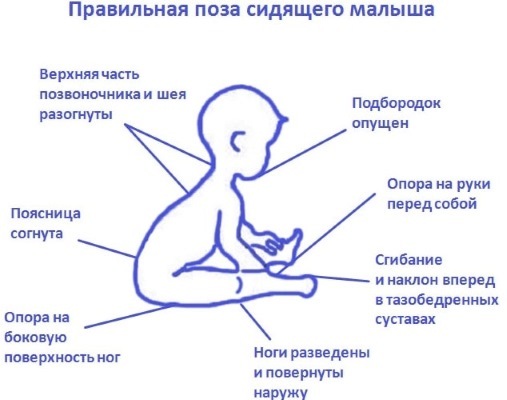
You can stimulate its activity like this:
- At 3 months, the child should already hold the head on its own. If he has difficulty holding the head, then he must be laid out on his tummy several times a day. If you spread toys around him, then he will turn his head in order to better examine them. You can strengthen the muscles in the chest, neck and arms with a wellness massage.
- At 4 months, the child should already grab various objects and his own legs on his own. When the baby starts pulling his toes into his mouth, his muscles will stretch. At this age, the baby still cannot sit on his own, but educational games will help him keep up with his peers and be ready to sit down on time.
- At six months, the child should already independently turn on its side. Parents can help him in this way: an adult helps the child to bend the leg at the knee and slightly winds it to the side. And the child can turn on his side in this position on his own.
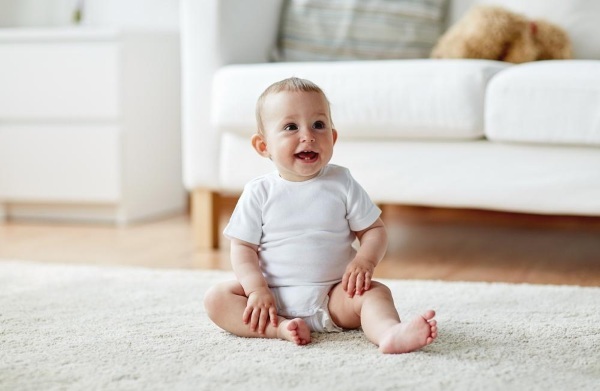
In other cases, when the child is simply lazy, physiotherapy exercises and massage can help.
Physical training
Parents can try to sit the child on their own, but not earlier than 6 months old, on a hard surface. But do not overload the child with serious stress. The first sitting lessons should be limited in time: initially, this should take no more than 10 minutes, 8 lessons a day.
But there are several conditions that must be observed when conducting classes with a six-month-old child:
- the child should be well-fed, but the lesson is carried out only half an hour after eating;
- classes are not held if the child is naughty or upset about something;
- it is better to conduct an activity in the fresh air, if, of course, there is such an opportunity.
During class, it is better to talk to the child, commenting on and explaining all the actions.
You can perform such a set of exercises with your child, but it is better to do it after preliminary warming up - stroking massage or taking a bath.
| An exercise | Peculiarities |
| Stretching the muscles in the legs | The child should be positioned on his back on a firm surface. Slowly and as gently as possible to pull the baby's legs, clasping the feet and not allowing them to bend at the knees. |
| Light massage | While the child lies relaxed, you can massage the tummy with your fingertips, and then the back in a circular motion. |
| Bicycle | You can take the child's legs by the heels and rotate them back and forth, performing the well-known exercise "bicycle".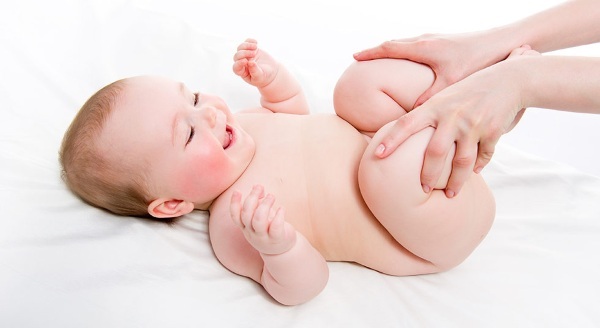
|
| Pull-up | One parent should give the child a thumbs-up for a firm grip on them. Give the child the opportunity to pull up on their own. |
| Wiggle | Put the child on his stomach to allow him to rest his hands against the surface on his own, lifting the body. After that, it is necessary to lightly swing the child from side to side in order to give him the opportunity to learn how to coordinate his movements. |
| Strengthening the muscle corset | Place a large toy at a short distance from the child. The child must reach her, if he succeeds, then the toy is simply moved one by one from one side to the other. It is important at this moment to monitor the balance of the child so that when trying to take a sitting position, he does not fall to one side. It is allowed that during this exercise the child turns the body in different directions. |
Exercise to strengthen muscles
So that the child can keep up with his peers and start sitting already at 6-7 months, crawling at 7-8 and standing on his own without support at 8-9 months is necessary regularly do simple gymnastics with him in the morning:
- To strengthen the abdominal muscles, simply bathing in an adult bathtub, which is filled to the top with water, will help, and a special holding circle is put on the child's neck. During bathing, the child will actively work with his legs, strengthening the muscles of the legs, pelvis and peritoneum.

- Crawling on bellies will help strengthen the spinal column, muscles in the peritoneum and legs, which is why pediatricians recommend teaching a child to crawl by placing in front of him a favorite toy that he wants in a favorite way get it. You can help him by placing your palms under your heels so that he has something to push off from.
- A playpen with a mesh with large cells will teach a child to grab them with handles, pull himself up and rise on his legs.
All of these exercises will help strengthen your muscles.
Massage and gymnastics to help the child crawl
According to experts, a special massage and a set of exercises, matched to the age of the child, will help him start crawling, keeping up with his peers. It is not necessary to seek help from a specialist, everything can be done at home 2-3 times a day, spending no more than a quarter of an hour on a lesson.
The following exercises give the best results:
- Strengthening the handles. It is imperative to choose the right moment when the child is in a good mood and only at this moment start doing the exercises. The child lies on his back, arms spread apart, and then bring them together, crossing them on the chest, but they should be straight. Alternately, you need to change the handles: right on top, then left. It is better if the child independently grabbed the thumbs of an adult with his fingers. Repeat the exercise up to 8 times.
- Strengthening the legs. The child lies on his back, gently take him by the shins and alternately bend one or the other leg at the knees, then two at once. Repeat up to 8 times. The child also lies on his back, an adult puts his hands like this: the thumbs are on the shins, and the rest of the fingers are on the knees. Straighten the legs and lift them vertically upwards, hold them in this position for a couple of seconds, and then lower them again. Repeat up to 8 times.
-
Learning to crawl. Put the child on his stomach, the hands of an adult lie on the heels of the child. With an energetic, but rather careful movement, bend the child's legs and press the heels to the buttocks. As a result, he will find himself in the "frog" position. After this, the child independently pushes off the hands of an adult and begins to crawl. But care must be taken that such movements do not cause discomfort. When the child gets used to the exercise, it is recommended to bend one leg alternately, stimulating cross crawling.

- Strengthening the abdominal muscles. The child lies calmly on his back. An adult gives him thumbs up so that he grabs them as tightly as possible, holds on to them tightly and independently, and seems to hang on them. Spread his arms to the sides and slightly pulling him to push him to sit down. Turn the child on his stomach, the legs are rested against the adult's torso. An adult puts his thumbs in the child's palms so that he clenches them in a fist, the rest of the fingers support the child's wrist. After the handles are raised through the sides, thus helping the child to kneel.
- Strengthening the back muscles. The child lies on his stomach, and at this time he is massaged, stroked, pinched, tapped along the entire spine. Be sure to start and end this massage with light and gentle strokes.
What to do to get your child to stand up
A child at 8-9 months does not sit, which means he will not crawl and stand either. Before you teach him to stand on his own, even if holding the handles on the support, you need to help him learn to sit down and crawl. It is advisable to make sure that the baby can already crawl at 9 months. If the child does not strive to crawl, then there is no need to put him on his feet ahead of time.
To help him, you need to properly develop and strengthen all the muscles in his body, using special gymnastics or massage. Classes for mom and baby in the pool help a lot. Children feel great in the water, especially if their mother is nearby. In each pool there is always a master who will help you choose a special set of exercises for mom and baby.
If the child has already been able to learn to stand on his feet, but cannot give up the support, then you can, after completing several exercises, help him feel more confident.
The following exercises will help:
- Training with fitball. To make it more convenient to perform the exercise, it is better to pump the ball not completely, but only 2/3. To sit the child on the ball, turning his back to an adult, it is better to hold him by the hips. After that, not abruptly, but smoothly tilt the child in different directions: forward, backward, to the sides. Such gymnastics helps to strengthen the muscles of the peritoneum, back, and normalize the functioning of the vestibular apparatus. You cannot let the child go so that he does not fall off the ball and injure himself. Fear can lead to the fact that the child will be afraid for a long time to stand without support.
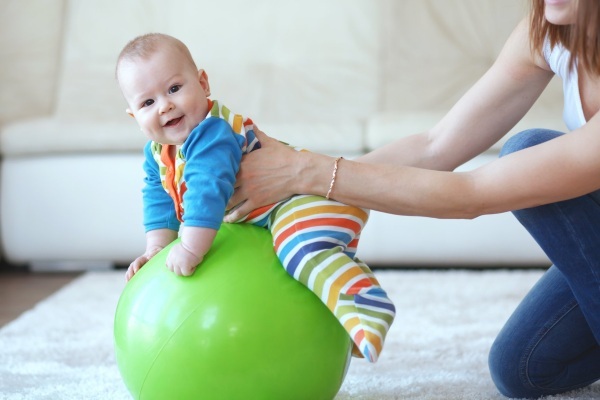
- You can put the child on the ball on his haunches, turning the back of his head towards you and holding him by the hips and swinging in different directions. The effect can be achieved if you stimulate him to straighten his legs. If he continues to remain in the same position, then this means that the muscles of his legs are not yet fully strengthened. Then the workout should be repeated in a week.
- It is better to wait for the moment when the child independently stands on his legs, holding on to the support. Then give him a toy that should interest him greatly, and then another one. As a result, the child will simply have to let go of his support in order to take the thing that interests him. In this case, it is important that both toys are new to him, otherwise he will simply throw the first one on the floor and never leave the support.
- Jumping swing. Today, in the children's store, you can purchase special devices that are fixed, for example, in the doorway. The child is placed in a soft, comfortable seat. The swing is equipped with an elastic band that allows the child to jump and still remain on their feet. As a result of such jumping, his spinal column, muscles in the calves and thighs are significantly strengthened.
A child does not sit on his own at 7-9 months - this is not a sentence yet. The main thing is to find out in time the cause of the developmental arrest, periodically perform developmental exercises and do massage, and he will be able to catch up with his peers. If the reason is related to the presence of an ailment, then it is important to diagnose in a timely manner and begin treatment.
Video about why the child is not sitting
Why is the child not sitting:



